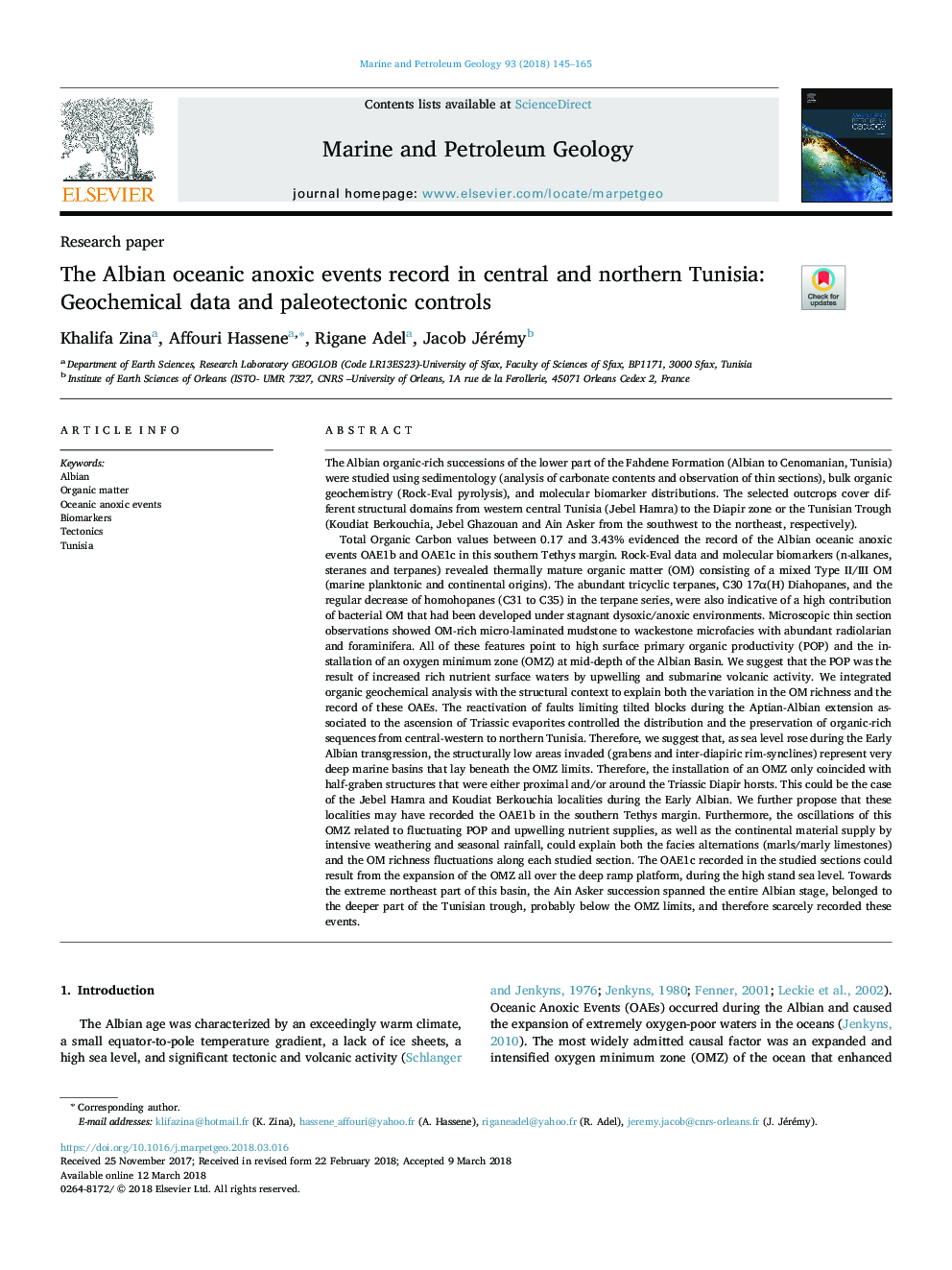| کد مقاله | کد نشریه | سال انتشار | مقاله انگلیسی | نسخه تمام متن |
|---|---|---|---|---|
| 8909080 | 1637132 | 2018 | 21 صفحه PDF | دانلود رایگان |
عنوان انگلیسی مقاله ISI
The Albian oceanic anoxic events record in central and northern Tunisia: Geochemical data and paleotectonic controls
ترجمه فارسی عنوان
رویدادهای آنابولیک اقیانوس آلبانی در مرکز و شمال تونس ثبت می شود: داده های ژئوشیمیایی و کنترل های پائئوتکتونیک
دانلود مقاله + سفارش ترجمه
دانلود مقاله ISI انگلیسی
رایگان برای ایرانیان
کلمات کلیدی
آلبیان، مواد ارگانیک، حوادث زهره اقیانوسی، بیومارکرها، تکتونیک، تونس،
موضوعات مرتبط
مهندسی و علوم پایه
علوم زمین و سیارات
زمین شناسی اقتصادی
چکیده انگلیسی
Total Organic Carbon values between 0.17 and 3.43% evidenced the record of the Albian oceanic anoxic events OAE1b and OAE1c in this southern Tethys margin. Rock-Eval data and molecular biomarkers (n-alkanes, steranes and terpanes) revealed thermally mature organic matter (OM) consisting of a mixed Type II/III OM (marine planktonic and continental origins). The abundant tricyclic terpanes, C30 17α(H) Diahopanes, and the regular decrease of homohopanes (C31 to C35) in the terpane series, were also indicative of a high contribution of bacterial OM that had been developed under stagnant dysoxic/anoxic environments. Microscopic thin section observations showed OM-rich micro-laminated mudstone to wackestone microfacies with abundant radiolarian and foraminifera. All of these features point to high surface primary organic productivity (POP) and the installation of an oxygen minimum zone (OMZ) at mid-depth of the Albian Basin. We suggest that the POP was the result of increased rich nutrient surface waters by upwelling and submarine volcanic activity. We integrated organic geochemical analysis with the structural context to explain both the variation in the OM richness and the record of these OAEs. The reactivation of faults limiting tilted blocks during the Aptian-Albian extension associated to the ascension of Triassic evaporites controlled the distribution and the preservation of organic-rich sequences from central-western to northern Tunisia. Therefore, we suggest that, as sea level rose during the Early Albian transgression, the structurally low areas invaded (grabens and inter-diapiric rim-synclines) represent very deep marine basins that lay beneath the OMZ limits. Therefore, the installation of an OMZ only coincided with half-graben structures that were either proximal and/or around the Triassic Diapir horsts. This could be the case of the Jebel Hamra and Koudiat Berkouchia localities during the Early Albian. We further propose that these localities may have recorded the OAE1b in the southern Tethys margin. Furthermore, the oscillations of this OMZ related to fluctuating POP and upwelling nutrient supplies, as well as the continental material supply by intensive weathering and seasonal rainfall, could explain both the facies alternations (marls/marly limestones) and the OM richness fluctuations along each studied section. The OAE1c recorded in the studied sections could result from the expansion of the OMZ all over the deep ramp platform, during the high stand sea level. Towards the extreme northeast part of this basin, the Ain Asker succession spanned the entire Albian stage, belonged to the deeper part of the Tunisian trough, probably below the OMZ limits, and therefore scarcely recorded these events.
ناشر
Database: Elsevier - ScienceDirect (ساینس دایرکت)
Journal: Marine and Petroleum Geology - Volume 93, May 2018, Pages 145-165
Journal: Marine and Petroleum Geology - Volume 93, May 2018, Pages 145-165
نویسندگان
Zina Khalifa, Hassene Affouri, Adel Rigane, Jérémy Jacob,
